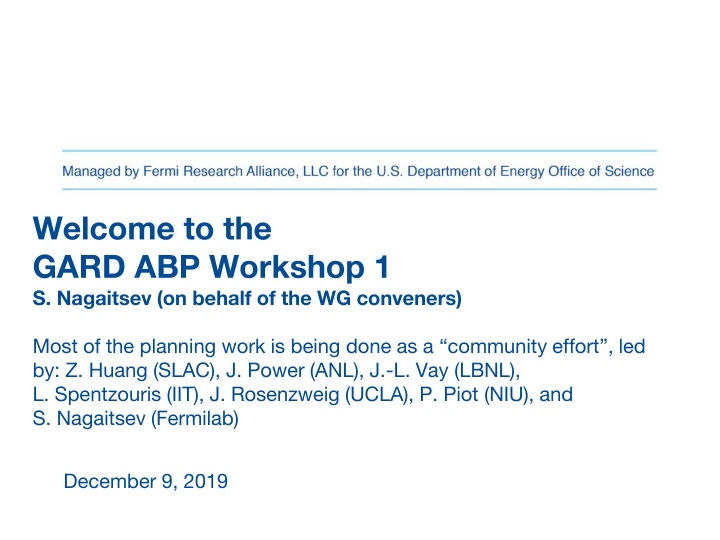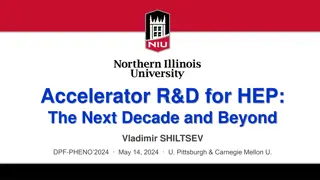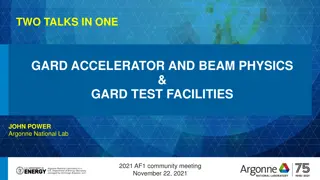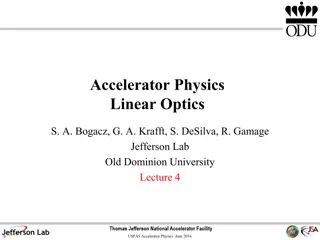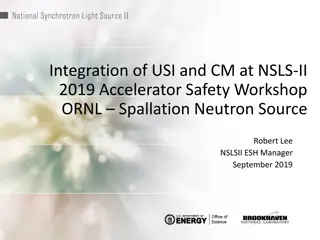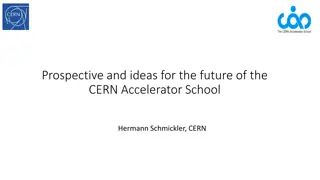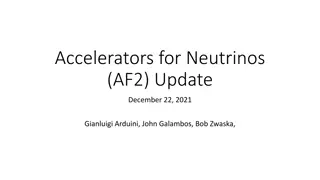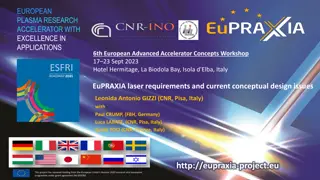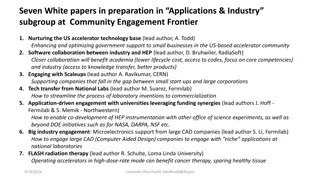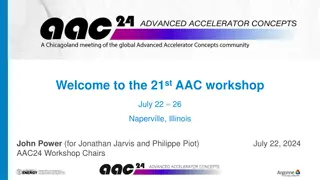Accelerator and Physics Research Needs Discussion at GARD ABP Workshop
The GARD ABP Workshop aims to discuss accelerator and physics research needs for High-Energy Physics (HEP) and define a strategic roadmap led by a dedicated group effort. The workshop builds on completed strategic planning for various GARD thrusts, emphasizing the distinctiveness, advancement of HEP goals, and help to DOE offices. Key elements include an exciting roadmap with great physics opportunities and alignment with the P5 report. The event serves to articulate strategic thinking and milestones towards defined outcomes.
Download Presentation

Please find below an Image/Link to download the presentation.
The content on the website is provided AS IS for your information and personal use only. It may not be sold, licensed, or shared on other websites without obtaining consent from the author.If you encounter any issues during the download, it is possible that the publisher has removed the file from their server.
You are allowed to download the files provided on this website for personal or commercial use, subject to the condition that they are used lawfully. All files are the property of their respective owners.
The content on the website is provided AS IS for your information and personal use only. It may not be sold, licensed, or shared on other websites without obtaining consent from the author.
E N D
Presentation Transcript
Welcome to the GARD ABP Workshop 1 S. Nagaitsev (on behalf of the WG conveners) Most of the planning work is being done as a community effort , led by: Z. Huang (SLAC), J. Power (ANL), J.-L. Vay (LBNL), L. Spentzouris (IIT), J. Rosenzweig (UCLA), P. Piot (NIU), and S. Nagaitsev (Fermilab) December 9, 2019
Why are we here? We are here to discuss the Accelerator and Physics research needs for the HEP and to define our long-term strategic road map. Most recent HEPAP presentation about GARD by J. Rosenzweig: https://science.osti.gov/hep/hepap/Meetings/201911 2 S. Nagaitsev | ABP Worshop 1 12/08/2019
3 S. Nagaitsev | ABP Worshop 1 12/08/2019
Introduction All GARD thrusts, except for the ABP, have now completed their strategic planning. AAC, RF, HFM are published OHEP has asked me (Aug 2018) to initiate, coordinate and lead this planning process for the ABP. It s a group effort. We started regular (weekly) phone meetings in Oct 2018. We hope that our roadmap would have the following features 1. It should be exciting and contain great physics opportunities (for labs and universities)! 2. It should be distinct (should not look like service to other thrusts or Ops). Also, distinct from CBB (NSF-funded) 3. It should advance the HEP strategic goals (at present, the P5 report) 4. It should be helpful to other offices within DOE. 4 S. Nagaitsev | ABP Worshop 1 12/08/2019
What is a roadmap? A roadmap is a strategic plan that defines a goal or desired outcome and includes the major steps or milestones needed to reach it. It also serves as a communication tool, a high-level document that helps articulate strategic thinking the why behind both the goal and the plan for getting there. 5 S. Nagaitsev | ABP Worshop 1 12/08/2019
2014 P5 report, 2015 GARD report, other GARD road maps https://www.usparticlephysics.org/ -- the P5 report https://science.osti.gov/~/media/hep/hepap/pdf/Reports/Ac celerator_RD_Subpanel_Report.pdf -- GARD report https://science.osti.gov/~/media/hep/pdf/accelerator-rd- stewardship/Advanced_Accelerator_Development_Strategy _Report.pdf -- the AAC roadmap https://science.osti.gov/~/media/hep/pdf/Reports/DOE_HE P_GARD_RF_Research_Roadmap_Report.pdf -- the RF roadmap https://science.osti.gov/~/media/hep/pdf/Reports/MagnetD evelopmentProgramPlan.pdf -- the HF magnet roadmap Notice that these are all DOE documents (more about it later) 6 S. Nagaitsev | ABP Worshop 1 12/08/2019
Synergies 9 DOE national labs claim Accelerator Science and Technology as one of their core capabilities: https://nationallabs.org/site/wp-content/uploads/2017/05/National-Labs-all-r.pdf The GARD ABP thrust shares many topics and physics issues with R&D activities at other (non-HEP) labs and universities OHEP is sensitive to the fact that they do not own the entire ABP phase space So, it is essential for us to invite ALL labs to our discussions and to get a buy-in from them. But we must focus on the HEP research needs Other DOE SC offices are very interested in what we are doing. 7 S. Nagaitsev | ABP Worshop 1 12/08/2019
Science is proposal-driven We are to bring to OHEP proposals for research and they respond (with guidance, requirements, and/or funding) Accelerator scientists (like all scientists) should be continuously proposing new ideas and experiments There is no clear single funding agency for Accelerator Physics at National Labs (like ASCR for computing) ECAs, NSF (for universities) GARD as a whole is to address Technology Gaps for HEP; ABP is supported as a small fraction. Our roadmap should address both Knowledge gaps and Technology gaps in Accelerator and Beam Physics. It will help OHEP to strengthen their case and it will help every scientist in our field. 8 S. Nagaitsev | ABP Worshop 1 12/08/2019
Our process Define ABP scope, mission, vision, challenges, activities Done (2018 2019) Collect ideas and research topics to address challenges and to advance the mission Two workshops, Dec 2019 (LBNL) and Mar 2020 (Fermilab) Start forming a roadmap: a timeline of R&D steps with milestones Draft a ~30-page document, describing the exciting research opportunities and the draft roadmap HEP Basic Research Needs Workshop on GARD ABP Sponsored by OHEP Example: https://www.orau.gov/brndrd2019/ Publish the Roadmap document, based on the workshop and our draft document 9 S. Nagaitsev | ABP Worshop 1 12/08/2019
Definitions and vision statement Accelerator and beam physics is the science of the motion, generation, acceleration, manipulation, prediction, observation and use of charged particle beams. The Accelerator and Beam Physics (ABP) thrust focuses on fundamental long-term accelerator and beam physics research and development. The ABP thrust explores and develops the science of accelerators and beams to make future accelerators better, cheaper, safer, and more reliable. Particle accelerators can be used to better understand our universe and to aid in solving societal challenges. 10 S. Nagaitsev | ABP Worshop 1 12/08/2019
GARD ABP mission statement The primary scientific mission of the ABP thrust is to address and resolve the Accelerator and Beam Physics Grand Challenges. Other equally important ABP missions are associated with the overall DOE HEP missions: Advance physics of accelerators and beams to enable future accelerators. Develop conventional and advanced accelerator concepts and tools to disrupt existing costly technology paradigms in coordination with other GARD thrusts. Guide and help to fully exploit science at the GARD beam facilities and operational accelerators. Educate and train future accelerator physicists. 11 S. Nagaitsev | ABP Worshop 1 12/08/2019
The 2014 P5 report provided physics drivers for accelerator R&D We should also anticipate the upcoming Snowmass process (2021) 12 S. Nagaitsev | ABP Worshop 1 12/08/2019
Snowmass 2021: DPF, DPB, DNP, DAP, DGRAV Snowmass 2021: https://indico.fnal.gov/event/22303/ Accelerator Science and Technology Frontier (Contacts: nsergei@fnal.gov , scousine@ornl.gov ) Accelerators for Neutrino and High Intensity Frontiers, and PBC (Physics Beyond Colliders) Accelerators for EW/Higgs sector Accelerators for Energy Frontier: p-p, mu-mu, e-e, gamma- gamma Accelerators for rare processes and precision measurements Advanced Accelerator Concepts Accelerator Science and Technology R&D: RF, high-field magnets, accelerator and beam physics, targets and sources, test facilities, synergies Townhall meeting at the Apr APS meeting 13 S. Nagaitsev | ABP Worshop 1 12/08/2019
ABP Grand challenges Grand challenge #1 (beam intensity): How do we increase beam intensities by orders of magnitude? Grand challenge #2 (beam quality): How do we increase beam phase-space density by orders of magnitude, towards quantum degeneracy limit? Grand challenge #3 (beam control): How do we control the beam distribution down to the level of individual particles? Grand Challenge #4 (beam prediction): How do we develop predictive virtual particle accelerators ? Link to Grand Challenges (a more detailed description): https://docs.google.com/document/d/11XhutaKropA9kToZhrYmCsoDf6oBunhuQ8mPgYhkJiA/edit?usp=sharing 14 S. Nagaitsev | ABP Worshop 1 12/08/2019
Thrust components [to be further discussed and developed by the ABP community through workshops] Thrust focus Intensity Frontier Energy Frontier: Hadron Energy Frontier: Lepton Synergies: SC/GARD thrusts Single particle dynamics and non-linear effects. Polarized beams X X X NP, BES Space charge effects and mitigation X X X NP, FES, BES Beam instabilities, control and mitigation; conventional wakefields X X X NP, BES, FES, GARD: AAC High brightness / low emittance beam generation: protons, ions, electrons, positrons, muons. Beam quality preservation and advanced beam manipulations. Beam-beam effects X X X BES, NP, FES, GARD:RF, HFM Thrust activities Beam cooling and radiation effects in beam dynamics; X X X BES, NP, GARD:AAC Advanced accelerator instrumentation and controls X X X BES, NP, GARD:AAC Modeling and simulation tools (including energy deposition); fundamental theory and applied math X X X BES, NP, FES ASCR, GARD:AAC, HPT Early conceptual integration and optimization, maturity evaluation (coordinated with other thrust) -- focus on science and technology X X X BES, NP, ASCR, GARD: AAC, HPT, RF, HFM 15 S. Nagaitsev | ABP Worshop 1 12/08/2019
Workshop #1 WGs Workshop #1 (LBNL, Dec. 9-10, 2019): (WG1) Single-particle dynamics, including nonlinearities, and spin dynamics. (WG2) High-brightness beam generation (including polarized beams), transport, manipulation and cooling. (WG3) Mitigation and control of collective phenomena: instabilities, space charge, beam-beam, beam-ion effects, wakefields, and coherent synchrotron radiation. (WG4) Connections to other GARD roadmaps (cross- cutting WG1-3) 16 S. Nagaitsev | ABP Worshop 1 12/08/2019
Workshop #2 WGs Workshop #2 (Chicago area, Mar 12-13, 2020): (WG1) Advanced accelerator instrumentation and controls. (WG2) Modeling and simulation tools (including energy deposition); fundamental theory and applied math. (WG3) Early conceptual integration and optimization, maturity evaluation (WG4) Connections to other GARD roadmaps; synergies with non-HEP 17 S. Nagaitsev | ABP Worshop 1 12/08/2019
Speaker guidelines Emphasize broad forward-looking research topics other than your specific R&D program Focus on your view of future challenges and methods to address those challenges. If you see connections between Workshop #1 and Workshop #2 topics, please list/flag them. S. Nagaitsev | ABP Worshop 1 12/08/2019 18
